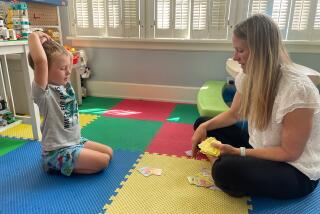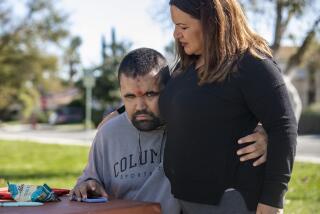Saving the Malfunctioning Family : Counseling Center Provides Therapy for the Whole Unit
- Share via
Nancy Steiny has met more than her share of saviors--most of them too young to drive a car.
There was the 7-year-old boy who chronically set small blazes, for instance. Desperate because she was unable to control him, the child’s mother brought him to the Southern California Counseling Center, where Steiny is director. As is often the case, according to Steiny, the delinquent child was simply acting as a warning buzzer for a malfunctioning family.
Thanks to the young fire-starter, the mother got therapy and the entire family was “saved.”
“We get very seriously upset families here,” said Steiny. As a low-cost counseling facility providing family therapy, the private, nonprofit organization at 5615 W. Pico Blvd. receives referrals from social-service agencies, as well as schools and hospitals. Family violence is a common theme.
“The kids in these families are sometimes the best therapists,” said Steiny, 60. “They can often turn out to be the hero or savior of a family by acting as a catalyst.”
Therapist Bonnie Thompson of Pacific Palisades added: “This can be very touching work. You see that children are protective of their parents and will do almost anything to take care of them.”
Lack of Coordination
Before the center began its family therapy component, the boy who played with matches might have been treated by one agency, the neglectful mother by another. Such cases “were very badly coordinated, or they weren’t coordinated at all,” said Steiny.
Founded in 1966 by psychiatrist Benjamin Weininger and psychologist Hans Hoffman, the center has long provided low-cost mental health care to individuals from all over Southern California. One hundred ten counselors volunteer their expertise; the center is funded by private donations and client fees, which average $6.50 a session and are determined on a sliding scale.
While individual counseling is still offered, family therapy has gained an increasing portion of the center’s workload. It all began five years ago when Steiny traveled east to study the tactics of structural family therapy pioneered by Dr. Salvador Minuchin of the Philadelphia Child Guidance Clinic. Although the approach is accepted by mental-health professionals in the East, family therapy has been slow in coming to California, Steiny said--perhaps because people often move here to escape their families.
Yet in working with troubled individuals, center volunteer counselors were consistently finding that their problems stemmed from past family interactions. “When I’m working with an individual, my feeling is always that I’m working as if the family were in the room,” said therapist Patricia Allee.
Learning how to treat an entire family was almost like starting over again for Steiny. (The center now has 20 counselors skilled in family therapy; 33 others are in training.) “Families are overwhelming,” she said. “We (therapists) trip up a lot. It’s hard work.
“But I’ve raised four children, and so many things about it (family therapy) make sense to me,” said Steiny, who has been married for 36 years. “Most of the fights people have where there is real heat--those are the kind of fights that are inherited from their families.”
Two years ago, the center strengthened its commitment to family therapy by adding two special rooms with one-way mirrors so that a team of counselors can help interpret the complicated dynamics of a family session. The rooms are furnished with more than the two chairs that are standard in a therapeutic setting.
Counselors who have been trained by Steiny agree that the intricacies of working with several related people are difficult to master. However, like Steiny, they are convinced that, as she put it: “It is an efficient way to work on some of our really dire problems (such as child abuse and neglect).”
Steiny said that the sliding-scale fee encourages families--who tend to try to work out conflicts on their own--to give therapy a chance.
Jill wasn’t satisfied selling advertising for a living, so she quit her job four year ago, sold most of her possessions and began showing up at the neighborhood newsstand at 6:30 every morning to buy the entertainment trade papers and look for acting roles.
Since then her life has been marked by personal and financial hardships. Jill (not her real name) began coming to the Southern California Counseling Center for help. But after several years of therapy, she was making little headway either with her career or her problems. Jill’s therapist decided no further progress could be made without involving her client’s family.
Jill, 33, sat beside her mother and father in one of the center’s new family therapy rooms on a recent afternoon. Her eyes were red and her hands made gestures of despair.
“I feel like I’m helpless right now,” she said. “I’m driving (with the gas gauge) on empty, borrowing money to eat. And they (her parents) won’t give me money, so there’s nothing to talk about. I’m sick of discussing it.”
Although the client in this case was an adult, the misunderstandings that arise between parents and children are similar no matter what their ages, Steiny said. She asked the three to position their chairs so that they were facing each other, rather than sitting side by side. Family therapy includes spatial manipulation of individuals; the green chairs in the family therapy rooms are always being rearranged.
“What you want a client to do is not to tell you but to show you what’s going on,” explained counselor Allee. She has clients enact what the scenario is like during pressured times at home, such as in the morning when everyone is hurrying to work and school.
The physical configuration of Jill’s family during the session showed that one or the other parent tended to side with the aspiring actress in her frequent pleas for financial assistance.
Steiny asked the parents to align their positions and make it clear to their daughter that though they supported her efforts, they could no longer provide monetary support.
“The real key in family therapy is to get the father and mother working together,” Steiny said. “That’s what gives children security and a sense of harmony.”
Although Jill was visibly unhappy with the conclusion that no more money was forthcoming, she couldn’t help but notice that for the first time her parents seemed to be united in their decision. Steiny said she felt a surge of relief in the room at the close of the session. And follow-up visits by the daughter revealed that the session had restored some equilibrium to the trio.
Whether the issue is money or child abuse, incest or divorce, the objective is the same--to turn a poorly operating family into a functioning one, said Steiny. “Functioning families enjoy each others’ differences and they give a lot of space to individual members. They’re flexible. They can take crises. And the parents work together.”
Steiny is convinced that with effort, even the most destructive family pattern can be transformed into a healthy one. “The reason I love my work,” she said, “is because I’m very optimistic about families.”
More to Read
Sign up for Essential California
The most important California stories and recommendations in your inbox every morning.
You may occasionally receive promotional content from the Los Angeles Times.













